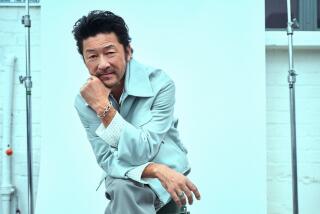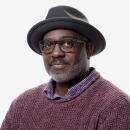Masi Oka of ‘Heroes Reborn’ on the fate of Hiro
In NBC’s original “Heroes” television show, Masi Oka’s character, Hiro Nakamura, was always the one to root for. The “master of time and space” had an unquenchable sense of justice and wonder at the world around him.
That did not change in the “Heroes Reborn” reboot, which just aired its fall finale, but it may be the last we see of Hiro.
Even when there were episodes with future Hiro — a more serious, dire version of the character — he was still a favorite. But in “Heroes Reborn,” Oka’s Hiro, though still a sword-wielding, time-stopping teleporter, is a much more paternal figure.
SIGN UP for the free Indie Focus movies newsletter >>
The character was held prisoner, his powers of time travel and teleportation hijacked by an evil corporation. He later has to watch over one of the children of Claire Bennett — the cheerleader played by Hayden Panettiere, remember? — until the child becomes a teenager. It was a bit of a departure for Oka as an actor, but a welcome addition to the character’s history.
The last image we saw of Hiro a few episodes ago was of a supposedly powerless man rushing headlong toward gun-toting agents — with two swords drawn. We’re not sure of Hiro’s fate, but we did catch up with Oka to get his final wishes for the character.
We also spoke about his experiences on the original show and his ventures into producing films and video games.
SIGN UP for the free Classic Hollywood newsletter >>
What was Hiro’s mindset in “Heroes Reborn”?
His mindset was that he is a little more mature. He still believes in the hero code, but I think, in a society where evos are being chased — and he officially runs his father’s company and he’s become the president — I think there’s a lot more responsibility.
He realizes that, going back to the “Heroes” days of going out and trying to save the world has a lot more practical consequences. I think he was just more mature, but still pure. He still believes in what’s right and what’s wrong.
How did you feel about, and how did you find out that, the show was coming back?
We found out about it through the Winter Olympics. The commercial came on, and we heard Wendy and Lisa’s theme, and I said, “Oh, wait a minute, that sounds familiar.” The logo came up, and I said “Whoa!” But it only said coming soon and nothing else.
I remember everybody — the veterans from the original show — we all got on a group chat and said, “Hey, did you all hear about this?” And nobody had heard about it, so we were all surprised. A few moments later, I get a call, and it’s like, “Hey, you got your dancing shoes on? Let’s talk.” Then I came in and met up with Tim [Kring].
I’m excited. It gives me a chance to finish off what we started. I have nothing but great things to say about the show and the character.
First of all, it was my first big break, and it’s a character I loved to play. It was fun to play, and it was also such a positive character. The fans also really enjoyed him. It’s an opportunity for me to give back to the fans and NBC and say thank you for the opportunity. Also, to pass the torch to the next generation of “Heroes” so that they can be successful. We want it to continue on and make a difference in the world.
Does being a visual effects artist and director cause you to look at what you do on screen as an actor differently? Can you see things other actors can’t?
I would say that there’s definitely some advantages with me being able to talk shop with some of the effects people. Because I come from a post-production world, I can speak shorthand with them. I don’t think many other actors can say that and know how the process 100% works.
I can get the respect from the post folks, but I also really respect what the post folks do. When they say, “Hey, would you mind stepping over two centimeters to your right?”, some actors might say, “No, I’m not going to do that!” I realize that that two centimeters can save hundreds of hours of roto work later on. It’s small things like that.
I can see, “Oh, visually, you’re going to composite me right here and add elements right here.” It definitely helps me be more of a visual actor. I can see myself outside of the scene.
We’ve seen what could be one possible fate for Hiro. What would you envision for Hiro?
The way I always wanted Hiro to end his story was to be in an infinite time loop with Charlie [Hiro’s love interest from Season 1, played by Jayma Mays.] That’s the way I would’ve loved to see him [go out].
I know in “Six Months Ago,” we kind of had the idea that he went back and back and back in time and couldn’t save her, but I think — it’s not like “50 First Dates” or anything — but I think for him to live and get lost in an infinite time loop through his love of Charlie would be a bittersweet way for him to finish his story.
I read the book “Saving Charlie.” That was a great love story.
Yeah. And the thing is, I think we lose him to an alternate universe, not just an alternate timeline. Maybe his powers grow so much that he can create an alternate universe where nobody can touch him, and he’s able to save Charlie. He sacrifices his powers and ability to jump around for that.
And be in a perpetual room full of origami swans and Charlie ...
Yes! That scene is still one of the most moving scenes I can remember.
So, what would be your top three scenes from “Heroes?”
Definitely the origami scene. It’s not as evident on the screen, but that room had so many origami cranes — it was so beautiful.
The other two scenes are probably me being on the show for the first time as future Hiro. That was such a game-changer, and I just loved what they did with the character. I was so ecstatic about that. It was just such a cool experience to be a different character.
And then the other one is probably my diner scene with Adrian [Pasdar] — when Hiro and he first meet. That was great because I have such good chemistry with Adrian — we actually drove up to the set the night before because he wanted to rehearse. It was the first time I actually worked on a scene with someone besides Ando. I didn’t know what to expect. But because we rehearsed, we had his great chemistry. Then there were so many things we could find in the moment in that scene that came out of improv.
What’s going on with Ando in “Heroes Reborn”?
I don’t know! There’s no real mention of him. There really isn’t enough time. Maybe he’s a vice president running around the world. Maybe they parted ways and he started his own company.
So, this is Hiro in the future, but it’s not the “future” Hiro we know, right?
Future Hiro never really existed. That was an alternate timeline, and you’ll see in “Heroes Reborn,” he has the same hairstyle, but he doesn’t have the goatee. I guess that’s another way of distinguishing them. He’s a hybrid. He hasn’t really gone evil, but he’s more mature. A separate Hiro who’s more controlled.
OK. Totally switching gears to a post-Hiro world:. You’re producing an adaptation of the manga/anime “Death Note.” Is that where you want to go in terms of your producing career — with anime and manga roots?
I grew up on anime and manga. That’s part of who I am. I’m still Japanese — a Japanese citizen with a green card and everything.
What I want to do is spread manga and anime even further in the mainstream — but in the right way. There’s some adaptations from the past — I won’t name any names — where it kind of lost its way.
When you’re making an adaptation, you have to make content for the fans, otherwise you’ll get something that won’t even be accepted by the mainstream. You want to make something that the fans will approve and the mainstream will enjoy.
I think those are two different things. If you just change it for the fans, then you get a limited audience, but if you don’t make something the fans enjoy, then you’re losing the core essence of what’s great about that property.
The idea of making a movie or a TV series is that the fans can be proud of it, but at the same time [it can] be enjoyed by a lot more and a new and bigger audience.
There’s so many amazing manga and anime that I want to get out and have the world enjoy. It’s part of who I am, it’s part of my identity and the bulk of what I produce is going to be related to manga and animation. As a producer, it’s my creative way to bridge the gap between the two cultures and find a happy medium where we can satisfy hopefully everybody.
And the mini mogul that you are becoming, you also dabble in gaming?
Yes! My other passion is games. I founded a company called Mobius Digital Games about two years ago. We just put out a really cool indie mobile game called “Beacon 38.” It’s an exploration game where the player has to escape the 38th dimension. It has an amazing art style with really cool game play where you have to use sonar to navigate through this beautiful alien world that’s constantly supplying challenges.
I’m very proud of it, but because it’s an independent game, it’s so hard to get the word out there. In the mobile market, people are so focused on the top, and we’re not into spamming. It’s a one-time download with no extras — I don’t want to pillage people’s wallets.
Follow me on Twitter @Storiz
More to Read
The biggest entertainment stories
Get our big stories about Hollywood, film, television, music, arts, culture and more right in your inbox as soon as they publish.
You may occasionally receive promotional content from the Los Angeles Times.











